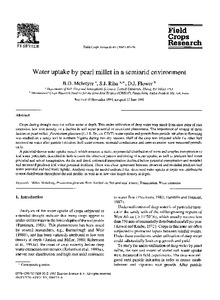Water uptake by pearl millet in a semiarid environment
Abstract
Crops during drought may not utilize water at depth. This under-utilization of deep water may result from slow rates of root extension, low root density, or a decline in soil water potential or associated phenomena. The importance of several of these factors on pearlmillet (Pennisetum glaucum (L.) R. Br., cv. CIVT) wateruptake and growth from panicle initiation to flowering was studied on a sandy soil in northern Nigeria during two dry seasons. Half of the crop was irrigated while the other half received no water after panicle initiation. Soil water content, stomatal conductance and stem extension were measured periodically. A potential-driven wateruptake model, which assumes a static, exponential distribution of roots and couples transpiration to leaf water potentials, described in both seasons the observed pattern and timing of wateruptake, as well as predawn leaf water potential and actual transpiration. As the soil dried, estimated transpiration declined below potential transpiration and modeled and measured predawn leaf water potential declined. There was close agreement between observed and modeled predawn leaf water potential and soil wateruptake. Analysis using the model indicated that decreased wateruptake at depth was attributable to root distribution throughout the soil profile, as well as to low root length density at depth

